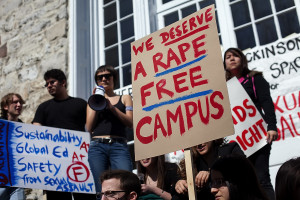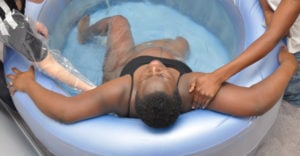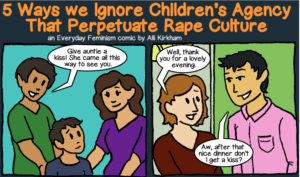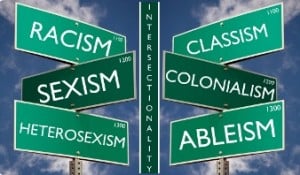Originally published on the Huffington Post and republished here with the author’s permission.
(Content Warning: Rape and rape culture)
In the first semester of my freshman year, heady with the sexual freedoms and experimentation that were the hallmarks of campus sexuality in the ’70s, I was assaulted by my ex-boyfriend.
My situation had all of the makings of a judicial disaster: My former boyfriend and I had a wildly sexual, visible relationship in my early weeks on campus.
My roommate let him into our double. He was drunk and upon waking, I didn’t tell him to leave.
When I refused sex, repeatedly, he forced intercourse while I cried. I didn’t fight.
My roommate, in the top bunk, also drunk, did not hear us or come to my aid. I did not get out of bed or ask for help.
In the morning, my ex staggered off with a hangover and no thought that anything was “wrong.”
I woke up devastated, and on a path that would include depression, lots of alcohol and drugs, additional assaults, and a decade of therapy to sort it all out.
Sexual assault on campus is nothing new.
And like me in 1979, first-year women in 2015 are at high risk for coercion, assault and rape by the men they are eating lunch with in the dining halls, working beside in study groups, and cheering on in the stadium.
What is new is this: Survivors of sexual assault and rape on campus are finally gaining traction in their demands that institutions address sexual violence from a survivor-centered framework of responsiveness and accountability.
Because the harsh truth is, despite legions of women like me from my generation and beyond, and decades of Take Back the Night rallies, most colleges remain stuck in a reactionary position that prioritizes the shielding of their endowments from lawsuits and the maintenance of their enrollment figures, above all.
It isn’t that colleges don’t believe situations like mine have existed for the past thirty years, it is that they have not defined what happened to me as assault, nor seen me and my sisters in these situations (and much worse) as worthy of protocols, processes and healing resources that would result in a critical re-ordering of institutional priorities, and equally important, a wholesale shift in campus sex cultures.
The reality persists that many – if not most – college sex cultures are predatory, with entrenched institutional policies that create the space for predators to thrive, including:
- No visible institutional definition of consent
- Key campus institutions, traditions, and events that have a history of sexual violence are glorified, the violence minimized or denied
- Sexually predatory behavior is framed as an aberration, a rarity, rather than woven into the campus culture and widely impacting the campus; a January 2015 study at the University of North Dakota found that 1-in-3 college men would “force sexual intercourse if they thought they would get away with it” (Newsflash: They are getting away with it!)
- When the men in the study noted above were asked whether they would “rape if they could get away with i,t” only 13.6% said yes. Colleges that are fuzzy about their definitions of consent and rape are responsible for this gap.
- Policies that focus on dealing with “a few bad apples” rather than the campus sex culture as a whole miss the mark.
- Housing and drinking policies work to place senior men at the top of social hierarchies and leave women and especially underclass women at risk for socializing in male-defined, upper-class-defined social spaces.
- Penalties for underage drinking make it impossible or problematic for underage drinkers to report assaults and rape.
- Approaches to prevention are generally simplistic, static, and anti-sex. They tend to be squeezed into already packed orientation programs and widely ignored.
- Administrative prevention programs can reinforce predatory sex culture by creating an anti-sex institutional posture that drives conversation about sex and sexuality underground.
- Resources for student-driven prevention initiatives are limited and controlled while administrative-driven prevention activities are funded and prioritized.
- Resources for survivors are hidden or hard to access; hush-hush rather than openly available and part of the community; survivors are thus seen as “damaged” and largely hide their assaults to avoid stigma and loss of social power.
- First responder protocols are driven by risk management strategies at the institution rather than survivors needs; for example: First responders should not be mandated to place survivors into a judicial process of any kind, but be maximally responsive to survivors’ physical and emotional well-being in the moment.
- Peer survivor resources are undervalued and underfunded.
- Sexual assault prevention in study abroad programs fail to address specific vulnerabilities; abroad programs fail to compile and report assault figures to students considering programs.
- Sexual assault protocols in abroad programs largely make it impossible for students to report and continue their programs; thus few report and their recoveries are significantly derailed; and the result is that data is not collected around predatory risks of particular programs and situations (such particulars might be a predatory community housing placement, a predatory program director, a dangerous social context, etc.)
- Transformational or restorative accountability processes driven by student and survivor initiative are not on the table.
Markers of a predatory campus sex culture include:
- No shared community standard or language of consent.
- No visible or accessible processes for redress in cases of assault.
- Gendered sex double-standards are entrenched, visible, supported and enforced – men and masculine-identified people gain social power via multiple fleeting encounters and women and feminine-identified people lose social power for the same activities.
- Disproportionate social power is accorded to white male athletes, certain teams, and/or male fraternity members.
- Upper-class, heterosexual men define the campus social culture through popular houses, campus traditions, or events.
- Male fraternities define the campus social culture through popular houses or events.
- Male athletes or teams define the campus social culture through long held traditions or events.
- Gender-conforming social mores reward traditional femininities and marginalize women who challenge male dominance in the social scene.
- White dominated campus social life marginalizes all people of color but especially women of color, who are either exotified or ignored socially.
- Feminism is an F word on campus.
- LGBTQIA+ students are marginalized socially and in campus leadership structures.
- Transgender students have limited physically accessible or social spaces and are objects of ridicule.
Conversely, hallmarks of a healthy, dynamic sex culture include:
- A vibrant, student-generated campus conversation on gender, sex, and sexuality that affirms each student’s sexual path.
- This vibrant conversation affirms a visible, shared definition of consent that all members of the community articulate and actively work to uphold.
- Respect for asexual and abstinent people; no loss of social power for aces and abstinent students.
- Women of color have the social power and social spaces to define their sexualities and pursue their partnerships of choice.
- Men of color are not exotified sexually while experiencing harassment by campus police and second class status as intellectual drivers on campus.
- Hook-up culture is not white male dominated, people of all races, genders and sexualities shape hook-up culture to their own needs; women and LGBTQIA+ students of all races experience hook-up culture as satisfying as heterosexual white men.
- Women and LGBTQIA+ students define social and sexual spaces; women’s and feminine spectrum people’s sexual desires and needs drive significant aspects of the campus sex culture.
- A variety of relationship configurations are possible and pursued, including short and long term dating, monogamous short and long term relationships, open short and long term relationships, polyamorous configurations, hook ups, playful sexual events and experiences.
- Exploration of desire and identity is experienced as a joyful and visible part of campus life and social development. Sexuality is sexual expression is not shameful, unspoken or underground.
- Survivors are a visible and vibrant part of campus sex culture, not “broken,” not a burden.
- All members of the campus community are free to form their sexual identities and practices, free of judgment, a loss of social power, slut shaming, ridicule or targeting for violence.
Needless to say, in 1979, I never reported my rape. Instead, I gained 25 pounds my first semester and went through periods where I barely left my room. I moved into a single the next semester to get out of the space where the rape occurred.
I drank more to deal with the labor of avoiding and removing myself from ex’s presence in social and unpredictable moments of interaction. I was alternately hyper vigilant about my sexual safety and highly drunk and vulnerable.
Many things in the lists above might have prevented my rape or improved my situation. My boyfriend was on the football team. He was an upperclassman – super social and well-liked.
In one of my first weeks on campus, he took me to his fraternity for a screening of Straw Dogs, an incredibly violent gang-rape film that one of the men had to stop watching because it made him physically sick (his teammates all laughed at him).
I looked around and noticed that almost all of the women in the room were freshman, like me. We had “arrived” socially by being invited to this “exclusive” social event by the popular guys on campus.
Date rape didn’t even exist as a term yet. None of us spoke up.
I don’t think my former boyfriend was an evil person. He certainly was not mentally ill. He read feminist texts; he liked strong women.
He was self-centered in a typical way that the racism and sexism of the era encouraged him to be. He was very, very entitled socially, and the sex culture on campus supported that sense of entitlement in myriad ways.
One of our early pillow talks was about how many people we had slept with on campus since arriving that fall. We had similar numbers, but when I told him mine, he was appalled.
He said: “You can’t do that here!” A line in the sand from an upper class male about the reigning sex culture – my sexual behavior was out of bounds.
Eventually, he demonstrated his belief in this double standard by ignoring my refusal of sex, and my tears, as he took what the campus sex culture colluded in defining as his right.
It took him many months to understand that what he’d done was violent, and that he’d harmed me.
It’s 2015.
In two years, I am sending my son off to college, and my daughter a few years after that. You can bet I will not be spending upwards of $50,000 a year to send them to schools that are protecting their multi-million dollar endowments at the expense of their students’ sacred bodies, spirits and sexualities.
You can also bet that I will be looking to send them to campuses where my children can easily assess both the prevailing sex cultures and institutional policies around assault prevention and redress.
We will review the lists I’ve outlined above as they consider the fabric of campus social hierarchies and sexual life and look at who is thriving and who is not.
You should, too.
[do_widget id=’text-101′]
Jaime M. Grant is a queer feminist writer/activist whose book, Great Sex: Mapping Your Desire, is forthcoming. As director of the Policy Institute at the National Gay and Lesbian Task Force, she served as principal investigator and co-wrote the groundbreaking report, Injustice at Every Turn: A Report of the National Transgender Discrimination Survey.
Search our 3000+ articles!
Read our articles about:
Our online racial justice training
Used by hundreds of universities, non-profits, and businesses.
Click to learn more





















